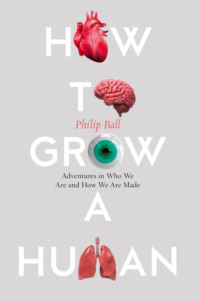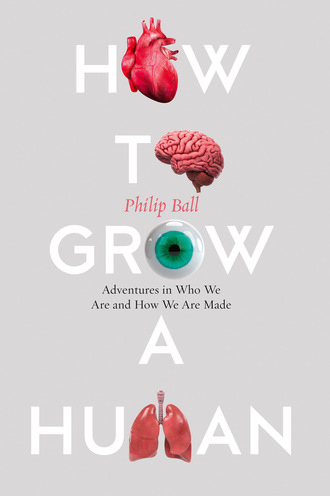
Полная версия
How to Grow a Human
Having your skin grown into neurons that assemble themselves into a brain organoid is a pretty convincing way to find out how obsolete that notion is. All the more so when you see it through the microscope and realize that this is not merely some trick of preservation. Life on that scale is multitudinous, and thriving, and it has a plan of sorts.
Life? Whose life?
Not mine, exactly – and yet who else’s can it be? Those cells are autonomous – but why any more so than the cells still in my arm, in my real brain (the need for that specifying adjective still makes me blink), my surging blood and beating heart? And so I come by degrees to accept the inevitable truth: I am a colony of cells, whose cooperation lets me draw breath, whose communication produces my sense of identity and uniqueness.
That is what is fundamentally disconcerting about our own flesh. It grew as a colony from a single cell, and we’re not quite sure where (or when) in this teeming morass to pin the label “me”.
The new cell technologies are making it impossible for us any longer to ignore this fact. I won’t pretend that I know how to normalize it, but I think there is a strange kind of liberation that can come from letting ourselves be unsettled by it.
CHAPTER 1
PIECES OF LIFE
CELLS PAST AND PRESENT
“Ex ovo omnia.”
So declared the frontispiece of Exercitationes de generatione animalium (1651) by the seventeenth-century English physician William Harvey, sometime physician to James I. It expressed a conviction (and no more) that all things living come from an egg.
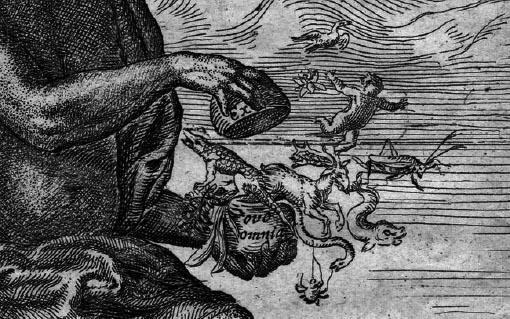
William Harvey’s motto “All things from an egg” in the frontispiece of his 1651 treatise on the “generation of animals”.
It’s not really true: plenty of living organisms, such as bacteria and fungi, do not begin this way. But we do. (At least, we have done so far. I no longer take it for granted that this will always be the case.)
“Egg” is an odd term for our generative particle, and indeed Harvey was a little vague about what he meant by it. Strictly speaking, an egg is just the vessel that contains the fertilized cell, the zygote in which the male genes from sperm are combined with the female genes from the “egg cell” or ovum. Yet it’s easy to overlook how bold a proposal Harvey was making, in a time when no one (himself included) had ever seen a human ovum and the notion that people might begin in a process akin to that of birds and amphibians could have sounded bizarre.
The truth of Harvey’s insight could only be discerned once biology acquired the idea of the cell, the fundamental “atom of biology”. That insight is often attributed to Harvey’s compatriot and near-contemporary Robert Hooke, who made the most productive use of the newly invented microscope in the 1660s and ’70s. Hooke discerned that a thin slice of cork was composed of tiny compartments that he called “cells”. This is often said to be an allusion to the cloistered chambers (Latin cella: small room) of monks, but Hooke drew a parallel instead with the chambers of the bee’s honeycomb, which in turn probably derive from the monastic analogy.
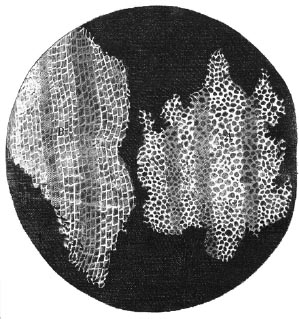
Robert Hooke’s sketch of cells in cork, as seen in the microscope.
The popular notion that Hooke established the cellular basis of all living things is wrong, however. Hooke saw cells, for sure – but he had no reason to suppose that the fabric of cork had anything in common with human flesh. In fact, Hooke imagined that cork cells are mere passages for transporting fluids around the cork tree. The cell here is just a passive void in the plant’s fabric, a very different notion from the modern concept of an entity filled with the molecular machinery of life.
More provocative were the observations of the Dutch cloth merchant Antonie van Leeuwenhoek in 1673 that living organisms can be of microscopic size. Leeuwenhoek saw such “animalcules” teeming in rainwater – mostly single-celled organisms now called protists, which are bigger than most bacteria. You can imagine how unsettling it was to realize that the water we drink is full of these beings – although not nearly so much so as the dawning realization that bacteria and other invisibly small organisms are everywhere: on our food, in the air, on our skin, in our guts.
Leeuwenhoek contributed to that latter perception when he discovered animalcules in sperm. That was one of the substances that the secretary of London’s Royal Society, Henry Oldenburg, suggested the Dutchman study after receiving his communication on rainwater. Leeuwenhoek looked at the semen of dogs, rabbits and men – including his own – and observed tadpole-like entities that “moved forward with a snake like motion of the tail, as eels do when swimming in water.” Were these parasitic worms? Or might they be the very generative seeds themselves? They were, after all, absent in the sperm of males lacking the ability to procreate: young boys and very old men.
Here we can see the recurrent tendency to impose familiar human characteristics on what is evidently “of us” but not “like us”. The French physician Nicolas Andry de Boisregard, an expert on tiny parasites and a microscope enthusiast, claimed in 1701 that “spermatic worms” could be considered to possess the formative shape of the fetus: a head with a tail. In 1694, the Dutch microscopist Nicolaas Hartsoeker drew a now iconic image of a tiny fetal humanoid with a huge head tucked up inside the head of a spermatozoa: not, as sometimes claimed, a reproduction of what he thought he could see, but a figurative representation of what he imagined to be there.

The “homunculus” in sperm, as imagined by Nicolaas Hartsoeker.
This was one of the most explicit expressions of the so-called preformationist theory of human development, according to which the human body was fully formed from the very beginning of conception and merely expands in size: an extrapolation down to the smallest scale of the infant’s growth to adulthood. According to this picture, the female egg postulated by Harvey continued to be regarded in the prejudiced way in which Aristotle had perceived the woman’s essentially passive role in procreation: it was just a receptacle for the homunculus supplied by the man.
That was, though, a different view to the one Harvey envisaged, in which the body developed from the initially unstructured egg. Harvey, like Aristotle, thought that semen triggered this process of emergence, which Aristotle had imagined as a kind of curdling of a fluid within the female. The idea that the embryo unfolds in this way, rather than simply expands from a preformed homunculus, was known as epigenesis. These rival views of embryo formation contended until studies with the microscope, particularly investigations of the relatively accessible development of chicks inside the egg, during the eighteenth and early nineteenth century put paid to the preformation hypothesis. Embryos gradually develop their features, and the question for embryologists was (and still is) how and why this structuring of the tissues comes about.
* * *
The observations of early microscopists did not, then, engender a belief that life is fundamentally cellular. That cells are a general component of living matter was not proposed until the early nineteenth century, when the German zoologist Theodor Schwann put the idea forward. “There is one universal principle of development for the elementary parts of organisms,” he wrote in 1839, “and this principle is in the formation of cells.”
Schwann developed these ideas while working in Berlin under the guidance of physiologist Johannes Müller. One of Schwann’s colleagues in Müller’s laboratory was Matthias Jakob Schleiden, with whom he collaborated on the development of the cell theory. Schleiden’s prime interest was plants, which were more easily seen under the microscope to have tissues made from a patchwork of cells, their walls constituting emphatic physical boundaries. This structure wasn’t always evident for animal tissues (especially hair and teeth), but Schwann and Schleiden were convinced that cell theory could offer a unified view of all living things.
Schleiden believed that cells were generated spontaneously within the organisms – an echo of the notion of “spontaneous generation” of living matter that many scientists still accepted in the early nineteenth century. But he was shown to be wrong by another of Müller’s students, Robert Remak, who showed that cells proliferate by dividing. Remak’s discovery was popularized – without attribution – by yet another Müller protégé, Rudolf Virchow, who tends now to be given the credit for it. All cells, Virchow concluded, arise from other cells: as he put it in Harveian manner, omnis cellula e cellula. New cells are created from the division of existing ones, and they grow between successive divisions so that this series of splittings doesn’t result in ever tinier compartments. Virchow proposed that all disease is manifested as an alteration of cells themselves.
Virchow was the kind of person only the nineteenth century could have produced – and perhaps indeed only then in Germany, with its notion of Bildung, a cultivation of the intellect that encouraged the emergence of polymaths like Goethe and Alexander von Humboldt. Virchow studied theology before taking up medicine in Berlin. While establishing himself as a leading pathologist and physician, he also became a political activist and writer and was involved in the uprisings of 1848. As if to demonstrate that nothing was simple in those times, this eminent biologist and religious agnostic was also profoundly opposed to Charles Darwin’s theory of evolution, of which his student Ernst Haeckel was Germany’s foremost champion.
Virchow thus had fingers in many pies; but in his view they were different slices of the same pie. The influence of politics, ideology and philosophy on science is always clearer in retrospect, and that’s nowhere more apparent than in the physiology of the nineteenth century. For Schwann, “each cell is, within certain limits, an Individual, an independent Whole”: an idea indebted to the Enlightenment celebration of the individual. The cell was a living thing – as the physiologist Ernst von Brücke put it in 1861, an “elementary organism” – which meant that higher organisms were a kind of community, a collaboration of so many autonomous, microscopic lives, in a manner that paralleled the popular notion of the nation state as the collective action of its citizens. Meanwhile, Schwann’s conviction of the cellular nature of all life, implying a shared structural basis for both plants and animals, was motivated by his sympathy for the German Romantic philosophical tradition that sought for universal explanations.
For Virchow, this belief in tissues and organisms as cellular collectives was more than metaphor. It was the expression writ small of a principle that applied to politics and society. He was convinced that a healthy society was one in which each individual life depended on the others and which had no need of centralized control. “A cell … yes, that is really a person, and in truth a busy, an active person,” he wrote in 1885. “What the individual is on a grand scale, the cell is that and perhaps even more on a small one.”
Life itself, then, showed for Virchow how otiose and mistaken was the centrist doctrine of the Prussian statesman Otto von Bismarck, who at that time was working towards the unification of the German states. Virchow attacked Bismarck’s policies at every opportunity and denounced his militaristic tendencies, so enraging the German nobleman that Bismarck challenged Virchow to a duel. The physiologist shrugged it off, making Bismarck’s belligerent bluster seem like the aristocratic posturing of a bygone era.
The idea of the “germ” as a rogue microbial invader was the counterpart to the idea of a body as a community of collaborating cells. It was entirely in keeping with the political connotations of cell theory that germ theory blossomed in parallel. Once Louis Pasteur and Robert Koch showed in the nineteenth century that micro-organisms like bacteria can be agents of disease (“germs”), generations of children were taught to fear them. Germs are everywhere, our implacable enemies: it is “man against germs”, as the title of a 1959 popular book on microbiology put it. After all, hadn’t a bacillus been identified as the cause of cholera in 1854? Hadn’t Pasteur and Koch established bacteria as the culprits behind anthrax, tuberculosis, typhoid, rabies? These germs were nasty agents of death, to be eradicated with a thorough scrub of carbolic. And to be sure, the antiseptic routines introduced by the unjustly ridiculed Hungarian-German physician Ignaz Semmelweis in the 1840s (as if washing your hands before surgery could make any difference!), and later by Joseph Lister in England, saved countless lives.
This new view of disease had profound sociopolitical implications. The old notion of a disease-generating “miasma” – a kind of cloud of bad air – situated illness in a particular locality. But once disease became linked to contagion passed on between people, a different concept of responsibility and blame was established. The politicized and racialized moral framework for germ theory is very clear in the description of a French writer from 1885 who talked of disease as “coming from outside, penetrating the organism like a horde of Sudanese, ravaging it for the right of invasion and conquest.” This was the language of imperialism and colonialism, and disease was often portrayed as something dangerously exotic, coming from beyond the borders to threaten civilization. Those who supported contagion theory tended to be politically conservative; liberals were more sceptical.
From the outset, then, our cellular nature was perceived to entail a particular moral, political and philosophical view of the world and of our place within it.
* * *
We come from a union of special cells: the so-called gametes of our biological parents, a sperm and an egg cell. Perhaps because this fact is taught in primary schools – a reassuringly abstract vision of human procreation, typically presented with no hint of the confusing richness and peculiarity of stratagems and diversions it engenders – we forget to be astonished by it. That we begin as a microscopic next-to-nothing, a pinprick somehow programmed with potential, is remarkable and counter-intuitive. It’s slightly absurd to image that infants will casually accommodate this “fact of life”, which seems on reflection barely conceivable. Only their endless capacity to accept the magical with equanimity lets us get away with it.
And so it continues through the educational grades: cells exist, and that is all we need to know. School children are taught to label their parts: the oddly named bits like mitochondria, vacuoles, endoplasmic reticulum, the Golgi apparatus. What has all this to do with arms and legs, hearts, brains? One thing is sure: the cell is anything but a homunculus. In which case, where does the body come from?
What the cell and the body do have in common is organization. They aren’t random structures; there’s a plan.
But that word, so often bandied about in biology, is dangerous. It doesn’t seem likely that we can ever leach from the notion of a plan its connotations of foresight and purpose. To speak, as biologists do, of an organism’s “body plan” is to lay the ground for the idea that there exists somewhere – in the cell, for where else could it be? – a blueprint for it. But it is not merely by analogy, but rather as a loose parallel, that I would invite you then to wonder where exists the plan, the blueprint, for a snowflake. There’s a crucial distinction between living organisms and snowflakes, and it is this distinction that explains why snowflakes do not evolve one from the other via inheritance but are created de novo from the cold and humid winter sky.1 But there are good motivations for the comparison, for the body’s organization, like the snowflake’s, is an instantiation of a particular set of rules that govern growth.
Virchow and his contemporaries were already coming to appreciate that cells are more than fluid-filled sacs. In 1831, the Scottish botanist Robert Brown reported that plant cells have a dense internal compartment that he called a nucleus.2 By Virchow’s time, cells were considered to have at least three components: an enclosing membrane, a nucleus, and a viscous internal fluid that the Swiss physiologist Albert von Kölliker named the cytoplasm. (Cyto- or cyte means cell, and we’ll see this prefix or suffix a lot.)
Kölliker was one of the first to study cells microscopically using the technique of staining: treating them with dyes that are absorbed by cell components to make their fine structure more visible. He was a pioneer in the field of histology, the study of the anatomy of tissues and their cells. Kölliker was particularly interested in muscle cells, and he showed that these are of more than one type. One variety has a stripy (“striated”) appearance when stained, and Kölliker noticed that striated muscle cells also contain many tiny granules, later identified as another component of animal cells that were named mitochondria in 1898. Around the same time, other substructures of the cell’s interior were recognized: the disorderly, spongelike folded membrane called the endoplasmic reticulum, and the Golgi apparatus, named after the Italian biologist Camillo Golgi. A vigorous debate began about whether the cell’s jelly-like internal medium – called the protoplasm – is basically granular, reticular (composed of membrane networks) or filamentary (full of fibrous structures). All of these options were observed, and the truth is that it depends on when and where you look at a cell.
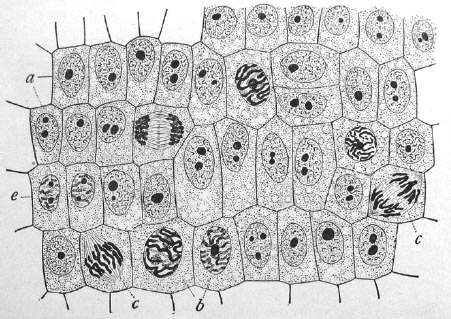
Images of onion cells drawn in 1900 by the biologist Edmund Beecher Wilson. These show some of the internal structures seen at different times in different cells. The single dense blob in several of these is the nucleus. Sometimes this seemed to break up into threads or blobs, perhaps in the process of cell division. What was going on in there?
All this internal structure led the zoologist Edmund Beecher Wilson to express regret that the term “cell” had ever been coined. It was a misnomer, he said – “for whatever the living cell is, it is not, as the word implies, a hollow chamber surrounded by solid walls.” Some others wondered if the cell was really the fundamental entity it had been supposed to be, not least because a cell membrane was not always visible under the microscope. Perhaps it was actually these organized contents in the protoplasm that were the real stuff of life? “We must be careful,” warned zoologist James Gray in 1931, “to avoid any tacit assumption that the cell is the natural, or even the legitimate, unit of life and function.”3
At any rate, the cell contained so much stuff. What was it all for?
It was becoming clear, too, what some of the key chemical components of cells are. Chemists interested in the processes of life – by the end of the century that topic was known as biochemistry – had figured out that they contain chemical agents called enzymes that carry out its characteristic panoply of metabolic reactions. Some enzymes, for example, allow yeast to ferment sugar into alcohol. In 1897, German chemist Eduard Buchner showed that intact cells weren’t necessary for that to happen: the “juice” that could be extracted from yeast cells could produce fermentation on its own, presumably because it still carried the crucial enzymes, undamaged, within it.
These molecular ingredients, like workers in a city, had to be organized, segregated, orchestrated in the time and place of their actions and motions. Chemical reactions in the cell have to happen in the proper order and in the right location; things can’t be the same everywhere in the cell. And so the “social” view of bodies as communities of cells was repeated for the single cell itself: it was a sort of factory populated by cooperating enzymes and other molecules. This hidden machinery enables a cell to persist and maintain itself, to take in substances and energy from the environment and use them to carry out the metabolic reactions without which there is only death.4
At the turn of the century, the substructure and organization on which the animation of cells depends was largely beyond the resolving power of the microscopes. But it was clear enough that not all cells are alike in their composition and structure. Bacteria and protists have rather little in the way of visible internal organization. They belong to a class of micro-organisms called prokaryotes, and they are typically round or elongated and sausage-shaped. The language of biological classification is always a little presumptuous, but it takes nothing away from bacteria to say that their cells are structurally relatively “simple”. They lack a nucleus – hence the label “prokaryotes”, meaning “pre-nucleus”. (More presumption – as though bacteria just haven’t yet discovered the wisdom of having a nucleus but will wake up to it one day. In fact, bacteria have existed for longer than eukaryotes; they and other prokaryotes dominate much of the planet’s ecology, and evidently have no need of “greater sophistication” in order to thrive.)
Human cells, along with those of other animals, plants, fungi and yeast, are said to be eukaryotes: a term that simply connotes that their cells have a nucleus. Eukaryotic organisms may be multicelled, like us, or single-celled, like yeast. The latter is an example of a “lower” eukaryote: more presumption, of course, but meaning that the degree of organization in the cell is less than that evident in the higher eukaryotes like peas, fruit flies and whales.
For now we can set prokaryotes aside. There is, mercifully, no need either to look in detail at what all the complex structure of the human cell is about, other than to say that it can be usefully regarded as a compartmentalization of the processes of existence. Membrane-wrapped substructures of the cell are called organelles, and each can be somewhat crudely considered to carry out a specific task. Mitochondria are the regions where a eukaryotic cell produces its energy, in the form of small molecules that release stored chemical energy when transformed by enzymes. The Golgi apparatus functions as a kind of cellular post office, processing proteins and dispatching them to where they are needed. The nucleus is where the chromosomes are kept: the material encoding the genes that are passed on when a cell divides or an organism reproduces. What we do need to hear more about, very shortly, are those chromosomes, because they are an important part of what defines you as an individual, and absolutely vital for orchestrating the life processes that enabled you to grow and which sustain you daily.
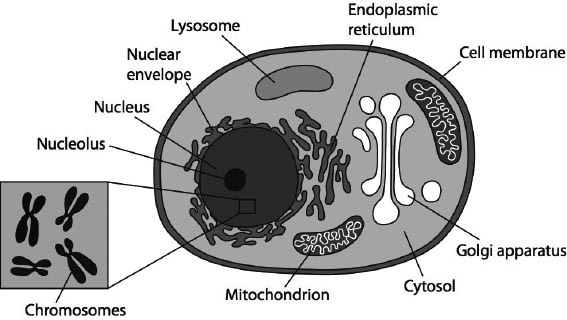
The human cell.
By the early twentieth century, it was clear that what sets living matter apart from the inanimate is not merely a question of composition: of what life is made of. Neither is it just a question of structure. Organisms and cells clearly did have a hierarchy of significant, specific yet hard-to-interpret structures reaching down to the microscopic and beyond. And that mattered. But the real reason living matter is not equivalent to some other state of matter such as liquids and gases is that it is dynamic: always changing, always in the process of doing something, never reaching a steady equilibrium. Staying alive is not a matter of luxuriating in the state of aliveness but is a relentless task of keeping balls in the air.




